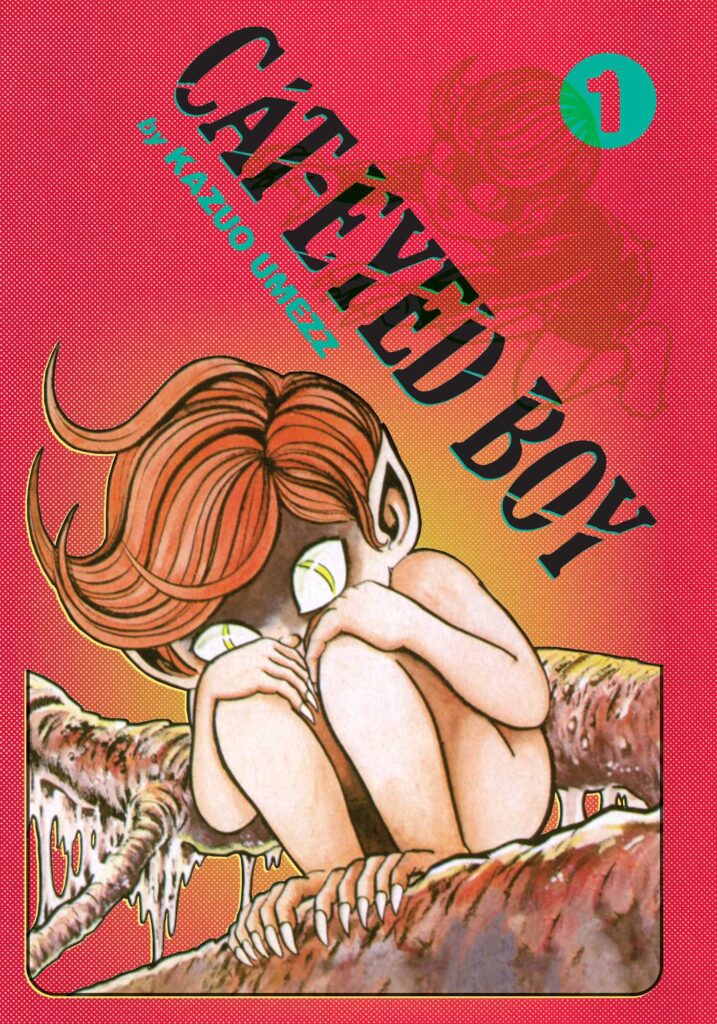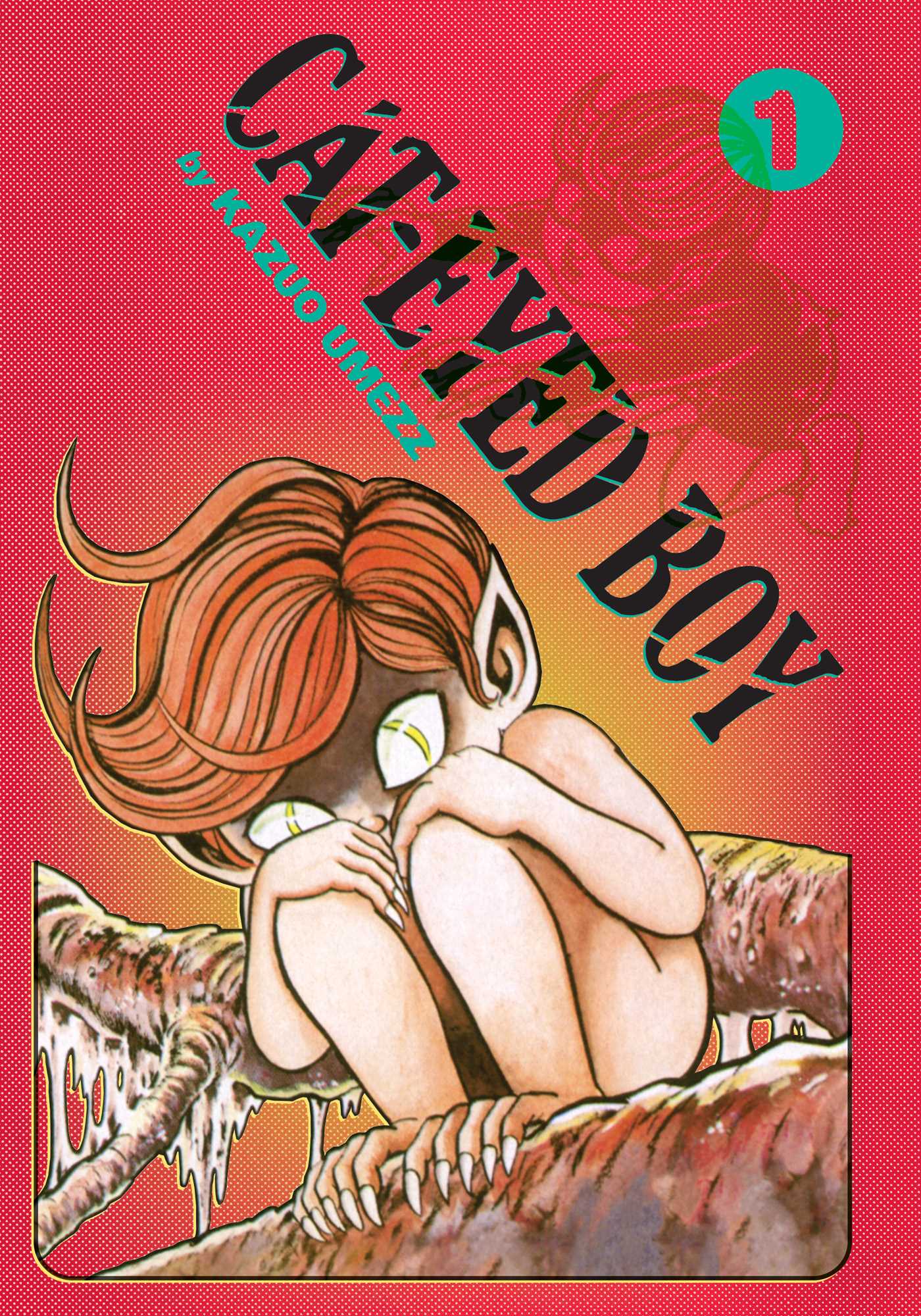Manga Review: Cat-Eyed Boy The Perfect Edition 1 by Kazuo Umezz
The “Cat-Eyed Boy” is the son of a nekomata cat monster who for reasons unknown but probably involving infidelity, was born far more humanoid in appearance than his parents. His mother died in childbirth and his putative father abandoned him some months later at a human shrine. Never given a real name, Cat-Eyed Boy is too monstrous in appearance to fit in human society but too human to be accepted by the youkai. He wanders from town to town, living in people’s attics, but wherever he goes, strange things happen.

This horror manga ran from 1967-69, with a brief revival in 1976, by the same creator as Orochi, which I’ve reviewed previously. This is one of two collected volumes.
“The Immortal Man” starts us off with Cat-Eyed Boy introducing himself. It’s been ten days since he started living in the attic of this mansion. Unfortunately, it appears that strange things are about to happen, not related to our mysterious lurker.
Wealthy kid Takeo is being chauffeured to school when the car hits an ugly man. When they get out of the car to check, the man has vanished. After school, Takeo is trying to get home in the rain when the ugly man offers to walk with him using an umbrella. Takeo isn’t willing to walk with him, but accepts a package from the man to give to his father. This package turns out to contain a severed forearm and hand. Not the ugly man’s, presumably as he had two hands.
The father recognizes the hand, and warns Takeo against further contact with the ugly man. Takeo’s not going to be able to keep that promise. The stranger is the “immortal man” of the title who can regenerate from wounds or missing body parts. And he claims to be Takeo’s real father.
Interestingly, it’s never made clear that the immortal man is the bad guy here per se. His behavior is certainly creepy, and one of his severed limbs regenerates on its own to become a monster, but we’re not given any proof that he’s lying and Takeo’s father is telling the truth. Nor do we learn any details of their shared past beyond that it might be blackmail material.
“The Ugly Demon” has a title character who’s born hideously deformed, shunned and reviled by everyone except his father. He responds to this abuse by becoming cruel, torturing and killing animals. No plastic surgeon could help. When he was twelve, he developed a crush on a pretty girl named Yuko. The “demon” stalked her and eventually wrote a letter asking her to be his friend. That ended exactly the way you’d expect. After that, she had a bodyguard who beat the demon if caught anywhere near Yuko.
Shortly thereafter, his father and he left town and seemingly disappeared.
Cat-Eyed Boy comes into the story ten years later, looking for a new place to live. A dying man warns him of a “beast.” Shortly thereafter, near an abandoned factory, Cat-Eyed Boy runs across a man going on all fours, with a handsome face marred by a head scar. The man is feasting on a corpse, and snarls like a cat.
The feral man attacks, knocking the wind out of our protagonist. Before the fight can go further, a strange man appears and cracks a whip to control the beast man. As Cat-Eyed Boy faints, the man introduces himself as Professor Yokai.
Cat-Eyed Boy is taken captive, and learns that Professor Yokai is a mad scientist. He’s into brain transplants, and has already tested it on the feral man, exchanging his brain with that of a leopard. Shockingly, the man volunteered for this. It’s the Ugly Demon’s father, who hoped that Professor Yokai would be able to fix his son.
Ugly Demon rejects Cat-Eyed Boy as a possible transplant donor, as the youkai is also monstrous in appearance. He wants a handsome, strong body that will allow him to be admired by society. But he’s going to use it to make “normal looking” people suffer.
As it happens, there’s a handsome young man who has been in a car accident and suffered terminal brain damage without marring his face or physique. Time for that brain transplant! But after what he’s suffered at the hands of Ugly Demon, Cat-Eyed Boy isn’t going to let the newly handsome monster have his own way.
It’s pretty clear that Umezz saw The Revenge of Frankenstein (1958).
“The Tsunami Summoners” is Cat-Eyed Boy’s origin story. After being left at the Nio (fierce protective spirit) shrine, the infant was cared for by Mimi, a spinster who wanted a child so much that she prayed to the Nio statue, and was willing to overlook the baby’s uncanny appearance. As he grew older, the Cat-Eyed Boy became mischievous, stealing whenever he was hungry, but Mimi tried to instill basic morality in him.
Eventually, the village priestess starts getting omens of doom approaching the community. It’s so overwhelming that she can’t get a reading on why the doom is coming, but the villagers decide it must somehow be the fault of Cat-Eyed Boy. It’s actually the Tsunami Summoners, youkai that disguise themselves as rocks and possess humans to take them to as high a place as possible, then summon a tsunami. They’ve been barred from the area for a long time by the Nio, but the Tsunami Summoners have a plan to get around that.
Cat-Eyed Boy tries to warn the villagers of the real threat, but even when he saves a baby from the ensuing flood, the villagers just assume that he was trying to eat the infant and is somehow responsible for the Tsunami Summoners being there. (“Cat-Eyed Boy: Threat or Menace?”)
“The One-Legged Monster of Oudai” has Cat-Eyed Boy crossing the title mountain when he sees a nail in a tree. He reaches towards it out of curiosity and it pops out of the tree, burying itself in his flesh. This is the work of the One-Legged Monster, and no matter what Cat-Eyed Boy does, he cannot remove the nail as it gets larger.
Meanwhile in nearby N City, a boy named Natsuo is an avid insect collector. He’s often been to Oudai to look for rare and unusual specimens. He does enjoy the local fame he’s getting for his collection, but his real joy is in stabbing the bugs to death with pins to mount them.
It turns out that the One-Legged Monster is angry at Natsuo for his unnecessary cruelty towards insects, and is using the Cat-Eyed Boy as a mobility aid to get its revenge. Our protagonist is not at all pleased at being used, but realizes that Natsuo was not an innocent.
“The Band of One Hundred Monsters” moves us into major plotline territory and only the first half is in this volume. Cat-Eyed Boy moves into the attic of a boarding house, one of the tenants being manga artist Taro Amadera. As it happens, Amadera-sensei specializes in horror manga featuring scary monsters, Umezz-sensei poking a bit of fun at himself.
Amadera is targeted by The Band of One Hundred Monsters (there are not actually one hundred members) a terrorist organization. As their leader Kodomo (“Child”) explains, despite their monstrous appearances and strange powers, the members of the gang are not in fact youkai but humans born that way, what Marvel Comics fans would call “mutants.” They resent being outcasts for their looks and have a hit list of particularly obnoxious “normal” humans that they plan to mutilate and humiliate.
The manga artist is their target because of his mean depictions of monsters. The band invites Cat-Eyed Boy to join them, but as he’s a “genuine” monster, he feels no kinship with “humans”, no matter how monstrous they look.
After the manga artist, the band targets a corrupt politician, and then a wealthy family that is rejoicing at the death of the miserly patriarch, but all intending to get rid of the others for the money.
Can the Cat-Eyed Boy protect the humans from the Band of One Hundred Monsters? Does he even want to?
There’s a certain amount of overlap between the themes of Cat-Eyed Boy and Orochi, they’re both drifters who become involved with weird events they stumble across. But while Orochi appears human enough to blend in, and is often the only overtly supernatural thing in her stories, Cat-Eyed Boy will never be able to pass as a normal or even slightly odd human, and battles other genuinely unnatural threats. His appearance tells against him, and it’s always assumed by the humans that he’s somehow to blame for the bad things happening. And honestly, he’s kind of a jerk, who’s more likely to fight the baddie of the story because they’ve personally offended him than that it’s the right thing to do.
Indeed, the main thing separating Cat-Eyed Boy from some of the villains of these stories is that he hasn’t allowed his hardships to turn him into someone who is deliberately cruel to others. He may have a low opinion of humans, but won’t usually go out of his way to do more than prank them. And every so often, he’ll do something genuinely nice. Not that this ever helps him gain acceptance.
Oh, and every so often, he’ll talk directly to the reader. “I know…I’ll stay at your house.” pointing his finger directly out of the panel.
There’s some cool monster designs and power usage, particularly in the One Hundred Monsters storyline. But other monster designs are just gross, and may put off the casual reader.
Content note: Violence, often fatal. Lots of body horror. Child abuse and cruelty to animals. Prejudice against people who don’t look sufficiently “human.”
This is old-fashioned horror for teenage boys, less cerebral than Orochi (which wasn’t all that deep itself.) Some of the endings are more open than others, with the menace not so much over as just gone. It was popular enough to spawn an anime (which is mostly still images with special effects) and a 2006 live action movie (not currently available in English.) Recommended to horror fans, but you may want to order it from the library.

